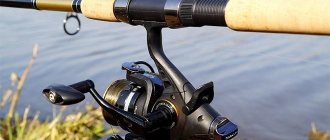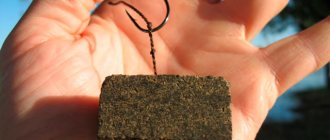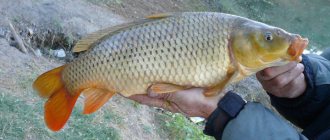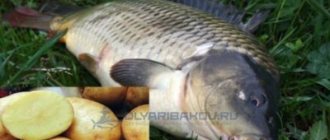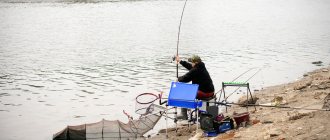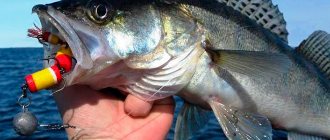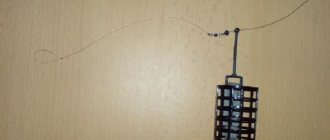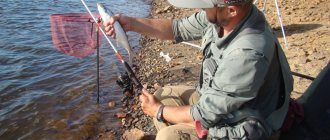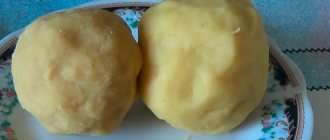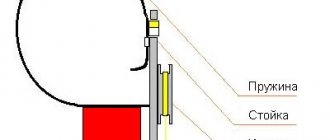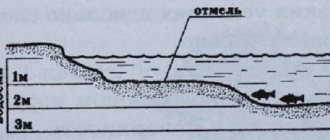This article will talk about how to catch carp on a feeder and how to equip a fishing rod, as well as what fishing techniques are best to use. Beginning fishermen should know that carp belongs to the carp family and is a fairly strong fish, therefore the tackle for catching it must be durable.
- The fishing line, together with various fasteners, must withstand a force of up to 10 kg. Cords from Salmo and Berkley have good characteristics.
- Basic accessories such as a rod and reel must also be able to withstand the appropriate loads. We can recommend carp rods from relevant companies, such as Banax, FOX, Sonic, etc.
Feeder rod
The choice of a feeder rod should be approached with great responsibility. It is better to give preference to, although expensive, proven brands and not waste money on cheap counterfeits. To catch carp, the rod must have the following characteristics:
- The length of the form is from 3.6 to 4.2 meters.
- Test load 100-150 g.
Based on this, you can choose a “Heavy Feeder” rod from brands such as:
- FOX, Sonic - quite expensive, but very high quality.
- Prologic, Wychwood, Banax - have a good price-quality ratio.
Coil
Having a high-quality and powerful fishing rod, you should think about equipping it with an equally reliable and powerful reel, especially since you will have to fight with strong fish. To all this we must add that you will have to make long casts with a heavy feeder.
A reel for such fishing must meet the following requirements:
- The slower the winding, the better (gear ratio from 4.1:1 to 4.8:1).
- Spool capacity 4500.
- The presence of at least 5 bearings.
- Have a "bayrunner".
The following coil models meet these requirements:
- "Banax Helicon 500NF".
- "Okuma Power Liner PL-860".
- "Trahucco Kalos CRB 6000 Brass Gear."
- "Daiwa Infinity-X 5000BR".
- "Salmo Elite Freerun".
- "Shimano Super Baitrunner XTEA".
The characteristics of the above reels allow you to cope with large carp without much effort, as well as cast the tackle further away. The presence of such a number of bearings ensures reliable and trouble-free operation of the reel. With the help of a “bayrunner” you can quickly turn off the reel brake, which will allow you to quickly respond to fish jerks.
fishing line
If there is a current, it is better to use a braided fishing line, especially since bites occur at a great distance. This line has a minimum specific stretch, which will allow you to instantly transfer all bites to the tip of the rod. In addition, it is more durable compared to monofilament fishing line.
You will need a fishing line with the following characteristics:
- The main line is 0.3-0.4 mm in diameter.
- Leashes - line thickness 0.25-0.28 mm.
- Load capacity from 7 to 10 kg.
You can offer fishing line from the following companies:
When choosing a fishing line, you need to pay attention to its “freshness”. Over time, the fishing line loses its characteristics, especially if it is not stored in proper conditions. As a rule, fishing line is stored at low temperatures, for example, in a refrigerator.
Having chosen a rod, reel and line, you should think about the equipment, which is important.
Feeder feeding technique
With the help of feeder equipment and suitable bait, you can attract carp to the chosen place.
The first series of casts is made without a hook, but only with a feeder. After the bait is applied, a hook is put on the equipment and the casting is repeated.
It is important to hit the same place every time, otherwise fishing will not bring results. To do this, during feeding and directly during the fishing process, you should use feeders of the same weight and shape, especially in the presence of a strong current.
For convenience, all casts should be made slightly upstream so that the line makes a right angle with the bank. In this case, fishing will be as easy as possible, but if you fish at an angle to the shore, then pulling the carp out from under the snags will be very difficult.
Feeding itself consists of a sequence of the following actions:
- All that remains is to leave the open feeder on the rig and remove the hook.
- Cast not at full strength and notice the direction in relation to some fixed landmark on the opposite bank.
- After the feeder falls into the water, place the feeder rod on the stand. The tension of the fishing line indicates that the feeder continues to fall to the bottom.
- Fix the length of the fishing line using a special clip on the spool of the fishing rod. This will allow the next casts to hit the same place with maximum force.
- Once the line has slackened and the rod has slightly straightened out, meaning the feeder has reached the bottom, you can wait about 10 seconds and then give a strong jerk with the rod so that the food is washed out of the feeder.
- Pull out the feeder and repeat 10-15 more times at intervals of about half a minute.
As for the position of the feeder, there are a number of techniques that can successfully combat its movement along the bottom.
You can do the following:
- Increase the weight of the feeder or add additional weights.
- Reduce the diameter of the fishing line and, accordingly, the force of water resistance.
- Raise the rod to a greater angle so that most of the line is above the water.
- Look for places with less current or cast closer to the shore where the current is slower.
Tackle for catching carp with a feeder and a Bolognese fishing rod: the right choice of rod, line and reel for two fishing methods.
A guide to feeder fishing for carp for beginner anglers: tackle, bait and fishing techniques.
Catching carp with boilies: recipes for cooking at home and techniques for catching carp with the right equipment.
Equipment for catching carp in the current
To effectively spend time on the shore of a reservoir, you will need to make the appropriate equipment. The following types of equipment can be used in the current:
- Gardner's paternoster;
- asymmetrical loop;
- "Method".
All of the equipment listed is widely used by fishermen. The paternoster and asymmetrical loop have been known for a long time, but the “Method” type equipment appeared quite recently. All equipment is very simple to manufacture and does not require a lot of time and money.
Paternoster
Asymmetrical loop
Method
After this, you can proceed to the next, no less important stage - preparing the bait.
Results
So, the key to successful fishing for carp in the current lies in the following steps:
- You need to choose good gear; a feeder is best, as it is specially designed for fishing in the current;
- Decide on the type of equipment; the most universal option is a paternoster, but those who like to feel every movement of the fish can use loops;
- Choose the right fishing spot, study the surrounding bottom;
- Apply groundbait and cast bait;
- Be patient and remain cool when fishing.
Bait for carp
As an option, for those who don’t want to stand near the stove, we can recommend ready-made commercial mixtures for carp fishing. Carp, as you know, is a wild carp. Mixtures from well-known manufacturers, such as Trapper, Dunaev, Sensas and others with various fruit fillings, are suitable for this.
To prepare bait at home you will need the following ingredients:
- Millet groats;
- Corn grits;
- Peas;
- Semolina;
- Oat flakes.
Recipe
- The water is brought to a boil, and ingredients such as barley, corn and millet grits, as well as peas are poured in.
- All components of the bait are cooked until fully cooked.
- Before the porridge is cooked, oatmeal and semolina are added to the main composition. All this time, the porridge is constantly stirred so as not to burn.
- During the cooking process, the mixture must be salted and flavored with unrefined oil.
- Once the porridge is completely cooked, remove it from the heat and leave to cool.
- Blue (or simple clay) is added to the main mixture. After it gets into the water, it leaves behind a visible trail, along which it is easy to determine how far the bait is carried. To one part of clay you should add 2 parts of bait.
- For greater viscosity, you can add a certain amount of dry cereal to the composition and flavor it with hemp oil.
The fishing technique largely depends on the presence of a current: if there is no current, then baiting the fish can be done the day before fishing, but if there is a current, this approach is inappropriate, and the fish will have to be fed during the fishing process. It is very important that the casts are dense enough to form a bait spot, rather than feeding a large area. Many fishermen add a purchased one to the mixture they prepare with their own hands, which makes the bait more attractive to the fish, and for the fisherman this is not a big savings, but it does save money.
What does the tackle for catching carp consist of?
Tackle for catching carp consists of:
- Rods. The fishing rod must be strong to withstand the pressure of even large prey. A length of up to 3.5 m will be optimal for long casts.
- Fishing lines – 0.5 mm;
- Capacious reel;
- Sinkers up to 125 g;
- Feeders. For standing water, a plastic feeder is suitable, for medium flows - lead, for strong flows - steel.
- Cord leash;
- Durable hook for carp;
- Carbine.
To increase the sensitivity of the gear, you can use a sliding feeder. The fishing line must be passed through a copper tube installed on the spring axis. A carabiner with 4 wires is attached to the end of the fishing line.
As a leash, you can use a braided thread with a diameter of 0.5 mm. The braid becomes softer every time, however, the strength does not decrease even after long fishing. The thread does not fray and does not alarm the carp.
When going fishing in Astrakhan, you can rent almost any gear at the Sazanya Bukhta base.
Float fishing rod
Suitable for weak currents, for fishing both from the shore and from a boat. Relevant rods for carp are 6 m or spinning rods up to 3 m.
A short rod is suitable for fishing from a boat, and a long rod is suitable for shore fishing.
The rod includes the following components:
- Spinning reel;
- Sinker;
- Sliding float;
- Hook depending on the prey (for large varieties, numbers 5 or 7 are suitable);
- Durable fishing line.
Donka
Bottom equipment involves catching carp without a rod. This way you can feed the fish at the bottom. Suitable for hunting from an inflatable boat.
Elements:
- Line up to 55 m;
- Leash up to 35 m;
- Powerful coil;
- Sinkers, depending on the current (with strong - up to 100 g, with weak - up to 70 g);
- Carp hook.
To begin with, the coil is inserted into the holder and secured with a nut. The fishing line is attached to the spool with a knotted loop. The end of the fishing line is passed through the rings of the spinning rod. At the end, the fishing line is wound onto a reel and the bracket is closed.
It is necessary to fix the feeder on the fishing line itself; another knotted loop is made at the end, onto which the leash is attached. Hooks are attached to the leashes.
Feeder
Feeder gear differs from bottom gear by the presence of tips that warn of a bite. Components of the tackle:
- Rod with a soft tip up to 4 m long;
- Powerful reel with two clutches;
- Strong fishing line 0.5 mm, at least 150 cm long;
- Leash up to 0.2 mm;
- The feeder is a sinker, so its weight must be at least 120 grams;
- Short hook.
Feeder equipment for carp
Makushatnik
Unlike the bottom equipment, the top rig uses a metal plate instead of a feeder, to which leashes with hooks are attached. Tackle elements:
- Sinker up to 100 g;
- Strong fishing line 0.5 mm;
- Hooks No. 8;
- A metal plate the size of a matchbox.
The cake is attached to the plate, as well as the hooks, disguised with bread and covered with clay. This design is very sensitive to any movements, so a bite can be detected instantly.
There is a wide variety of gear for catching pike perch, the choice depends only on the fisherman. However, it is important to understand that carp is a large fish, so the main thing is that the equipment is strong and can withstand the pressure of even trophy specimens.
TAGS:
Lures
In order for your fishing gear to be complete, you need to take care of the bait. There are several interesting solutions for catching carp:
- You need to take the crumb of black bread and processed cheese. All this is mixed into a homogeneous mass from which small balls are rolled. They are subsequently placed on a hook.
- Carp and carp love corn, so you need to take the corn grains and boil them, after which they can be strung on a hook.
- Boiled potatoes and a couple of drops of unrefined oil (sunflower) are added to the bread crumb. Balls are prepared from the resulting mixture and attached to a hook.
- Carp does not mind eating freshly cooked peas. It is cooked until it is ready so that it does not fall apart, but is soft. Peas as a whole can also be placed on a hook.
- A dough is kneaded from wheat flour and water, after which the balls are rolled and fried in sunflower oil. The finished balls can be strung on a hook.
- You can use boilies to catch carp. After the preparatory operations, when everything is ready, you can go to the reservoir to catch carp. For greater results, you need to try and find a suitable place for fishing.
In the summer, the fish does not stand still, but constantly migrates across the reservoir in search of food. Despite this, she has a constant route, and every day she goes to the same places where she can find food. As a rule, the carp chooses places where there are a lot of snags or there are rubble of entire trees, which are then inhabited by many species of fish, including the carp.
Fishing technique
The process and success of catching carp mainly relies on and depends on the experience of the fisherman.
The following main points should be noted here:
- After casting a hook with bait, you must secure the rod properly, otherwise the fish, having swallowed the bait and jerked strongly to the side, can tear the rod out of the stand and drag it into the water.
- Carp, as a rule, hooks itself, so there is no need to make additional movements and jerks after the fish grabs the bait.
- Once hooked, a carp tries to go somewhere into the thicket or under a snag, from where it is difficult to pull it out. In this case, it is best to re-attach the rod and wait until the fish comes out on its own.
- Having entered free water, the carp strongly resists, makes sharp jerks and can break, tearing its lip. You need to lead it confidently, without relaxing, even when the carp rises to the surface - this does not mean at all that its resistance will decrease. Even in the last meters he fights to the last, so when fighting you should remain calm and collected until the very end.
